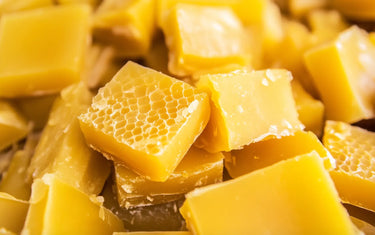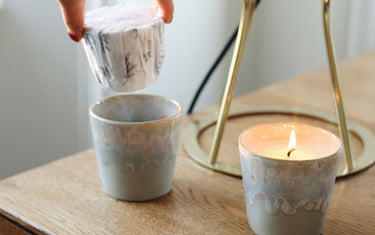5 min read / 21 June 2023 / Laura Garvin Gomez
How to Make a Candle Burn Easily
Master the art of effortless candle burning with our expert tips and tricks.
Share this post

If you are wondering, “Why is my candle not burning evenly?” there may be a few simple adjustments that you need to make in order to create a steadier burn.
Although lighting a candle is easy, getting it to burn evenly so you minimise wax wastage is a skill that is often learnt over time. To show you how we’ve put together a list of helpful tips that will help you get more from your candle wax.
How to make a candle burn evenlyTo learn how to make candles burn evenly, try some of our suggestions below, which should give you more control over how the wax develops once the flame has been lit. 1. Burn on an even surfaceFor a candle to burn evenly, it needs to be placed onto an even surface to allow the max to melt equally. The floor surface is just as important, as even when a candle is placed onto a table or floor standing shelving, if the surface below is uneven, this can also affect the burn quality. 2. Try multi-wick candlesMost candles rely on a single wick, but larger jar candles with 2 or 3 wicks can help to create a more even burn. The wax will melt faster and should also burn more evenly as there are multiple sources of heat working in tandem, especially on candles with a wider diameter. 3. Cut down the wickIf you regularly burn candles, it’s a good idea to invest in a pair of wick trimmers, although you can also use nail clippers or a pair of scissors. Ideally, the wick should be kept between ⅛ and ¼ inches in length for it to burn well. The longer the wick, the bigger the flame, which leads to burn pools that create an uneven burn. |
4. Use a lighter or longer matches
How you light the candle will also affect the way it burns. By using a lighter or long match, you can reach the wick more easily and also make it safe to ignite. Lighting the candle with short matches can cause the flame to flicker, forcing the wax to melt unevenly as soon as it comes into contact with heat.
5. Let the wax burn evenly across the top
When you are burning a candle, by letting the upper layer of wax burn right across the surface area you should be able to prevent it from tunnelling. This is particularly important on the first burn, as it prevents the wick from sinking deeper into the middle of the candle to create a tunnel effect. Memory rings are left behind the first time a candle is lit, and the more even they are, the better it will burn when relit. A candle that has tunnelled is not only more difficult to light but also more dangerous as you need to reach down further to ignite the wick.
6. Use foil to melt tunnelled candles
Even with the very best preparation a candle may still start to tunnel. But there is a useful trick you can use to melt tunnelled wax to restore its evenness. Light the candle as normal and then wrap aluminium foil around the top of the candle jar to create a rounded cover (that sits about 3 inches above the flame) with a centre opening. It should only take a couple of hours to melt the wax back down to an even level, after which you can remove the foil and burn the candle as usual.

7. Keep the candle away from drafts
As we mentioned above, a flickering flame will push the heat unevenly across the surface of the wax causing it to melt faster in some areas. Place the candle in an area away from any drafts or breezes to minimise flickering, which will allow the flame to remain stable so the wax can melt evenly.
8. Have a 4-hour burn time limit
Whether or not you are constantly in the room as the candle is burning, be sure to keep an eye on its progress from time to time. A maximum burn time of 4 hours is a good guideline to follow, although this can differ depending on the type of wax being used (burn time information is usually provided by most sellers).
9. Don’t blow out the flame
Most people will blow out a candle as it is the easiest way to douse the flame. However, snuffing out the flame is the best option, as it means the melted wax is not being spread across the candle as you blow. It also prevents any ashy debris from the wick being blown into the wax. Depending on how hard you blow into the candle, it can also sometimes cause the wax to spray onto the surrounding surface, which is tricky to clean up. Holding a candle snuffer, or a metal spoon, over the flame for a few seconds will prevent oxygen from getting to the flame so it can stop burning by itself.

10. Let the candle cool before re-igniting
When a candle has been blown out, let the wax harden and cool down before you relit it. For most candles it usually takes around two hours for the wax to cool and harden, which will make it easier to light and avoid the likelihood of the wick drooping over into the hot wax, making it more difficult to use.
11. Store the candles correctly
Candles will also need to be stored well for you to get the most out of them. Keep them in cool, dark and dry areas of your home, ideally in a container that will prevent dust and debris from becoming attached to the wax.

When you’re learning how to make a candle burn evenly, you may only need to use one or two of the above suggestions. The quality of the wax, the location of the candle and your previous experience will all influence what you need to do. Take care when lighting and extinguishing the flame on a candle because even though the flame is small, there is always the possibility of an accident occurring. Most importantly of all, enjoy the calming relaxation that comes with lighting a candle and with a few minor adjustments, you should be able to get more from your burn time.











